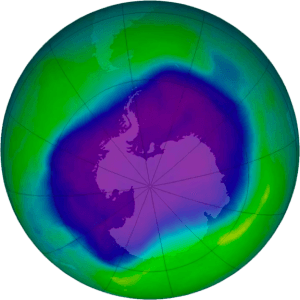New threat to the ozone layer
By: John Beute ‘20, 2/20/18

The extent of the ozone hole over Antarctica (Source: Wikipedia)
In 1987, the UN enacted an emergency measure known as the Montreal Protocol to ban the use of chlorofluorocarbons—more commonly known as CFCs. Scientists had discovered that CFCs were destroying the layer of ozone in the stratosphere that protects the planet from harmful radiation. Since then, the ozone layer has begun to heal, but a new class of chemicals used today may slow down or even reverse the healing process entirely (1).
CFCs are a class of chemicals known as long-lived ozone-depleting substances, or ODSs (2). ODSs destroyed part of the ozone layer over Antarctica by reacting with the ozone molecule, which is made up of three oxygen atoms, and breaking it down. The extent of the damage done to the ozone layer up until 1987 was so severe that it may take decades before the ozone reverts to pre-1980 levels (1).
The Montreal Protocol effectively reduced emissions of long-lived ODSs, and their atmospheric abundances are declining. David Oram, a research fellow from the UK’s National Center for Atmospheric Science, states that the depletion of the ozone layer “is a well-known phenomenon and, thanks to the success of the Montreal Protocol, is widely perceived as a problem solved” (3).
But Oram emphasizes that the problem is not solved. There are certain chemicals that are not regulated by the protocol which present a growing threat to the ozone layer. These chemicals are known as VSLSs, or very short-lived substances (2).
Due to their short atmospheric lifetimes of less than 6 months, VSLSs were not regulated under the Montreal Protocol and were not believed to pose a serious threat to the ozone layer. However, emissions of VSLSs have been increasing rapidly in East Asia over the course of the past several years. When the chemicals reach the atmosphere in significant quantities, they can cause damage (3).
One VSLS, known as dichloromethane, is particularly concerning. Oram and his team discovered a 60% increase in the atmospheric abundance of dichloromethane over the past decade. The team also detected dramatic increases in several chlorine-containing VSLSs and 1,2-dicholorethane in the air above East Asia (2).
Oram recounted that the discovery was a surprise, because the cause of the sudden increase was unclear. While emissions of VSLSs such as dichloromethane have been relatively stable in the developed world, Oram suspected that “the new emissions could be coming from the developing world, where industrialization has been increasing rapidly” (3).
The team collected air samples on the ground in Taiwan and Malaysia between 2012 and 2014 to measure the abundance of VSLSs. The team also utilized data from a passenger aircraft that flew over Southeast Asia. Both sets of data showed that the abundance of VSLSs is increasing and reaching the atmosphere at higher rates (3).
Through their research on VSLSs, Oram and his team demonstrated a clear gap in the Montreal Protocol—one with profound implications for the health of the planet, and one that should be addressed sooner rather than later for the sake of our future.
References:
(1) Puiu, T. (2015, February 18). “Short-lived chemicals that burn a hole in the ozone layer are on the rise.” ZME Science. Retrieved October 15, 2017 from www.zmescience.com/ecology/cli
mate/short-lived-chemicals-ozone-layer-053234/
(2) Oram, D. E., Ashfold, M. J., Laube, J. C., Gooch, L. J., Humphrey, S., Sturges, W. T., Leedham-Elvidge, E., Forster, G. L., Harris, N. R. P., Mead, M. I., Samah, A. A., Phang, S. M., Ou-Yang, C.-F., Lin, N.-H., Wang, J.-L., Baker, A. K., Brenninkmeijer, C. A. M., and Sherry, D.: A growing threat to the ozone layer from short-lived anthropogenic chlorocarbons, Atmos. Chem. Phys., 17, 11929-11941, https://doi.org/10.5194/acp-17-11929-2017, 2017.
(3) European Geosciences Union. (2017, October 12). New threat to the ozone layer. ScienceDaily. Retrieved October 14, 2017 from www.sciencedaily.com/releases/2017/04/170420
170420141844.htm